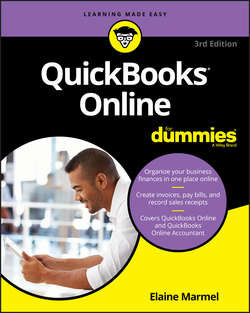Читать книгу QuickBooks Online For Dummies - Marmel Elaine - Страница 13
На сайте Литреса книга снята с продажи.
Part 2
Managing the Books for the End User
ОглавлениеIN THIS PART …
Become familiar with the QBO interface.
Manage list information needed to use QBO.
Enter transactions in QBO to update your company’s books.
Use reports to examine the condition of your company.
Chapter 3
Creating a Client Company in QBO
IN THIS CHAPTER
❯❯ Signing up for a QBO account
❯❯ Setting up a new QBO company
❯❯ Understanding the interface
❯❯ Working with company settings
❯❯ Updating the Chart of Accounts
❯❯ Working with multiple currencies
❯❯ Examining QuickBooks Labs
After you sign up for QBO, you log in. QBO then prompts you to set up your company. With certain limitations, you can import a company if you’ve been using a QuickBooks desktop product. Or, you can use the QBO Setup wizard, as shown in this chapter.
For details on importing a company, see Chapter 12 (or ask your accountant to help you with the import). And, don’t worry, if you don’t import your entire desktop company; you can import just the list information from that company, as described in Chapter 4. Importing lists will still save you a lot of time and setup work.
Signing Up for QBO
After you complete the sign-up process for a QBO account, Intuit, by default, logs you in to your account and walks you through the process of setting up your QBO company. The process is short – much shorter than the one you go through when setting up a QB desktop product company – and you need the following information:
❯❯ Your company’s name and address
❯❯ The industry in which your company operates
❯❯ Your company’s legal organization (such as S-Corp or Limited Liability Partnership)
❯❯ Whether you want to import company information from a QuickBooks desktop product
❯❯ The types of payments you accept from your customers (that is, cash, checks, and credit cards)
❯❯ The way you want to handle payroll
To sign up for a QBO account, follow these steps:
1. Visit quickbooks.intuit.com/online.
2. Scroll down the page until you find the three boxes describing each version of QBO.
3. In the version of QBO that you want to try, click the Free 30-Day Trial link.
The Free 30-Day Trial link appears below the Buy Now button.
Be aware that the price you pay for QBO depends on whether you choose the Buy Now option or the Free 30-Day Trial. If you opt to “buy now,” you pay less for your subscription because discounts don’t apply to the Free 30-Day Trial.
4. Fill in your name, email address, and a password (see Figure 3-1).
If you already have an Intuit user ID, supply that user ID and password.
Your password must be between 6 and 32 characters and consist of a mix of letters and numbers. The password can also contain some special characters; I included an exclamation point (!) in my password and it was accepted. The user ID and password you supply are the ones you use each time you log in to QBO.
5. Click the Sign Up button below the boxes you completed in Step 4.
At the time that I wrote this, a window appeared that offered the option to skip the free trial and buy the product at a discounted rate. You can buy, but I opted to click the Continue to Trial button.
FIGURE 3-1: Fill in the information needed to start the free trial.
QBO sets up your free trial, logs you in to QBO, and displays the Set Up wizard … read on.
Setting Up a New Company
When you first sign up for a QBO account, Intuit logs you in to your QBO account and, by default, displays the set up wizard. The first screen of the wizard, shown in Figure 3-2, asks for basic company information.
FIGURE 3-2: Provide basic company information.
As you supply address information, QBO automatically prepares an invoice form that contains the information; you’ll use this form (or a variant of it) to prepare the invoices you send to customers.
Конец ознакомительного фрагмента. Купить книгу
